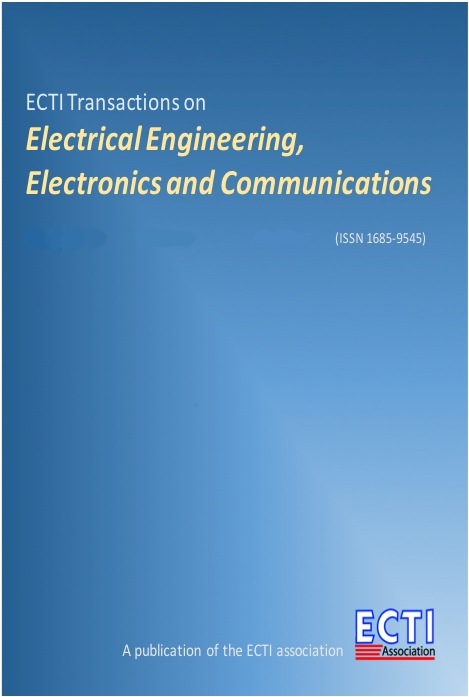Optimal Fuzzy Sliding Mode Controller Design using Bee Algorithm for Dynamic Voltage Restorer System
Main Article Content
Abstract
This paper proposes an application of the bee algorithm (BA) in order to design an optimal proportional-integral-derivative (PID) controller, a sliding mode (SM) controller, and a fuzzy sliding mode (FSM) controller for a dynamic voltage restorer (DVR) system. The DVR is an electronic device, which has excellent dynamic capabilities and is well-suited in protecting critical or sensitive loads from short duration voltage sags or swells. The parameters of the optimal PID, SM, and FSM controllers are automatically tuned by the BA to compensate for the magnitude of load voltage by injecting the compensating voltages when the source voltage sags and swells. In order to confirm these concepts and to show that the proposed strategy outperforms other strategies when it is compared to others using the trial and error method, experimental and simulation setups were implemented in various cases.
Article Details

This work is licensed under a Creative Commons Attribution-NonCommercial-NoDerivatives 4.0 International License.
This journal provides immediate open access to its content on the principle that making research freely available to the public supports a greater global exchange of knowledge.
- Creative Commons Copyright License
The journal allows readers to download and share all published articles as long as they properly cite such articles; however, they cannot change them or use them commercially. This is classified as CC BY-NC-ND for the creative commons license.
- Retention of Copyright and Publishing Rights
The journal allows the authors of the published articles to hold copyrights and publishing rights without restrictions.
References
[2] A. Ghosh and G. Ledwich, “Compensation of distribution system voltage using DVR,” IEEE Trans. on Power Delivery, Vol. 17, No.4, pp. 1030-1036,
[3] V. S. C. Raviraj, and P. C. Sen, “Comparative study of proportional integral, sliding mode, and fuzzy logic controllers for power converters,” IEEE Transactions on Industry Applications, Vol. 33, No.2, pp. 518 –524,
[4] P. K. Nandan and P. C. Sen, “A comparative study of proportional integral proportional controllers for DC motor drives,” International Journal on Control, Vol., No.1, pp. 283-297, 1986.
[5] P. C. Sen, “Electric motor drives and Control-Past, Present, and future,” IEEE Trans. Ind. Electron, Vol., No.6, pp. 562-575, 1990.
[6] J. Fernando Silva, Power electronics handbook, Academic Press, San Diego, 2001, ch. 19. V. Utkin, “Variable structure systems with sliding mode,” IEEE Trans. on Automatic Control, Vol. AC- No.2, pp. 212-222, 1977.
[7] J. J. E. Slotine and W. Li,Applied Nonlinear Control,Prentice-Hall, New Jersey, 1991.
[8] K. J. Astrom and B. Wittenmark, Adaptive Control. Reading, Addison-Wesley, MA, 1995.
[9] M. K. Passino, Fuzzy control, Addison-Wesley, London, 2000.
[10] L. Ingber and B. Rosen, “Genetic algorithms and very fast simulated reannealing: A comparison,” Mathematical and Computer Modelling: An International Journal, Vol. 16, No.11, pp.87-100,
[11] D. E. Goldberg, Genetic Algorithms, Addison-Wesley, MA, 1989.
[12] D. Fogel and A.V. Sebald, “Use of Evolutionary Programming in the Design Of Neural Networks For Artifact Detection,” Proceedings of the Twelfth Annual International Conference of the IEEE
Engineering in Medicine and Biology Society, pp.1409, 1990.
[13] D. Ahr and G. Reinelt, “A tabu search algorithm for the minmax k-chinese postman problem,” Computers& Operations Research, Vol. 33, pp. 3403-3422, 2006.
[14] R. Storn and K. Price, “Differential evolution – a simple and efficient heuristic for global optimization over continuous spaces,” Journal of Global Optimization, Vol. 11, pp. 341–359, 1997.
[15] H. Falaghi, M. R. Haghifam and C. Singh, “Ant Colony Optimization-Based Method for Placement of Sectionalizing Switches in Distribution Networks Using a Fuzzy Multiobjective Approach,” IEEE Transactions on Power Delivery, Vol. 24, No.1, pp. 268 - 276, 2009.
[16] J. Kennedy and R. Eberhart, “Particle swarm optimization,” Proc. IEEE Int. Conf. Neural Networks, pp. 1942–1948, 1995.
[17] M. R. Banaei, S. H. Hosseini., S. Khanmohamadi and G. B. Gharehpetian, “Verification of a new control strategy for a dynamic voltage restorer by simulation,” ELSEVIER Simulation modeling practice and theory, Vol. 14, pp.112- 125, 2006.
[18] P. C. Sen, “Electric motor drives and Control-Past, Present, and future,” IEEE Trans. Ind. Electron, Vol. 37, pp.562-575, 1990.
[19] N. Mohan, T. M. Undeland and W.P. Robbins, Power Electronics: Converters, Applications, and Design, John Wiley and Sons, Inc., New York, 1989.
[20] Tarkeshwar Mahto and V. Mukherjee. “A novel scaling factor based fuzzy logic controller for frequency control of an isolated hybrid power system”. Energy. 2017; 130 : 339-350.
[21] C. Fitzer, M. Barnes, and P. Green, “Voltage sag detection technique for a dynamic voltage restorer,” IEEE Trans. On Industry Applications, Vol. 40, No.1, pp. 203-212, 2004.
[22] S.W. Kim and J.J. Lee, “Design of a fuzzy controller with fuzzy sliding surface,” Fuzzy Sets and Systems, Vol. 71, pp.359-367, 1995.
[23] D.T. Pham, A. Ghanbarzadeh, E. Koc, S. Otri, S. Rahim and M. Zaidi, The bees algorithm, Technical Report, Manufacturing Engineering Centre, Cardiff University, UK, 2005.


